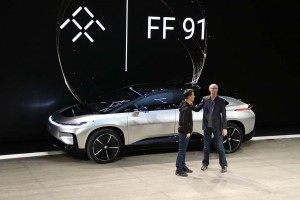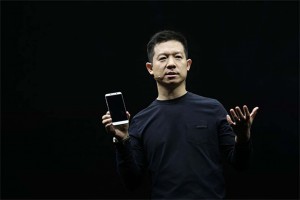
Nick Sampson, (r), one of the Faraday Future founders, is shown with investor Jia Yueting, (l) at the debut of the FF91 concept in January 2016.
The California-based battery-car company Faraday Future is “effectively insolvent,” according to co-founder Nick Sampson who resigned on Tuesday.
His departure comes as the once-promising company prepares for a second round of mass layoffs, a Faraday spokesman advised TheDetroitBureau.com late Tuesday evening. Faraday had already laid off a sizable number of its approximately 1,300 employees last week as it struggled to find enough cash to continue operating.
“There is a furlough pending,” said spokesman Jacob Brown, adding that Faraday needs to take “drastic measures, but the executive team wants to keep the company running.”
(Faraday fritters away funding. Click Here for our earlier report.)
Founded in April 2014, and named for Michael Faraday, a British scientist whose research in electromagnetic induction helped create the first electric motor, the company was originally backed by Jia Yueting, an entrepreneur frequently referred to as “China’s Steve Jobs.”
Faraday Future has been working on an autonomous battery-car dubbed the FF91 that was unveiled at the Consumer Electronics Show in January 2016. It originally was supposed to go into production by the end of this year at a plant just outside of Las Vegas. But the middle of that year, Jia ran into a series of financial setbacks that forced him to curb his financial support for both Faraday and a second electric vehicle start-up, LeEco.
Faraday subsequently scrapped the Las Vegas plant project and shifted production plans to an existing factory it acquired in Hanford, a small town south of Fresno.
(Tesla bucks the forecasts, turns a rare profit for Q3. Click Here for more.)
About the same time, it lined up a new backer in the form of China’s Evergrande Health Industry Group, which agreed to provide $2 billion in new funding, paid in several tranches, if Faraday met a series of targets.
But Evergrande backed out of the deal after pumping in only $800 million, leaving Faraday scrambling for new cash. It took the investor to court in Hong Kong and last week was given permission to seek new financing, though none appears to be immediately at hand, leading to the first of those “drastic” steps last week, with the initial round of layoffs.

Chinese billionaire Jia Yueting had to back out of investments with both Faraday and another battery-car start-up, LeEco.
In a formal statement, Faraday said, “Recent actions taken by Evergrande (are) causing FF to experience extraordinary financial hardship. The investor has intervened in the Company’s capital planning and is preventing FF from utilizing our assets, which requires FF to take some very difficult yet necessary actions.”
With a second round of layoffs expected to impact the vast majority of its remaining workforce, Peter Savagian, Faraday’s senior vice president of technology and product development resigned on Monday, a day before Sampson tendered his own resignation.
In a statement of his own issued outlining his reason for leaving, Sampson wrote that, “The company is effectively insolvent in both its financial and personnel assets, it will at best … limp along for the foreseeable future. I feel that my role in Faraday Future is no long(er) a path that I can follow, so I will leave the company, effective immediately.”
He added that, “I cannot continue knowing the devestating [sic] impact we are having on the lives of our employees, their families and loved ones as we (see the) ripple effect this will have on lives throughout our suppliers and the industry as a whole.”
Faraday is describing the planned job cuts as a “two-month furlough,” indicating workers could be back on the job in January, though that appears to depend upon raising additional capital. Some workers will remain on the job, it added in its statement, albeit at “a reduced level of compensation.”
According to spokesman Brown, the company’s remaining management team is looking to raise “$500 mil which will jumpstart everything and, hopefully, get everything started back up again.”
(Click Here for a look at the finalists for Green Car of the Year.)


I thought Faraday was one of two EV manufacturers to move to somewhere in Arizona (though no one knows where in Arizona).
They started building a plant in NV but scuttled the project, then took over another existing plant in Hanaford, CA.